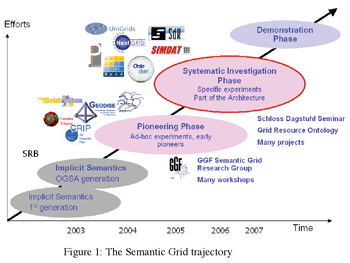The Grid aims to support secure, flexible and coordinated resource sharing by providing a middleware platform for advanced distributing computing. Consequently, the Grid’s infrastructural machinery aims to allow collections of any kind of resources—computing, storage, data sets, digital libraries, scientific instruments, people, etc—to easily form Virtual Organisations that cross organisational boundaries in order to work together to solve a problem. A Grid depends on understanding the available resources, their capabilities, how to assemble them and how to best exploit them. Thus Grid middleware and the Grid applications they support thrive on the metadata that describes resources in all their forms, the Virtual Organisations, the policies that drive then, and so on, together with the knowledge to apply that metadata intelligently.
The Semantic Grid is a recent initiative to systematically expose semantically rich information associated with Grid resources to build more intelligent Grid services.1 The idea is to make structured semantic descriptions real and visible first class citizens with an associated identity and behaviour. We can then define mechanisms for their creation and management as well as protocols for their processing, exchange and customisation. We can separate these issues from both the languages used to encode the descriptions (from natural language text right through to logical-based assertions) and the structure and content of the descriptions themselves, which may vary from application to application.
In practice, work on Semantic Grids has primarily meant introducing technologies from the Semantic Web2 to the Grid. The background knowledge and vocabulary of a domain can be captured in ontologies – machine processable models of concepts, their interrelationships and their constraints; for example a model of a Virtual Organisation.3 Metadata labels Grid resources and entities with concepts, for example describing a job submission in terms of memory requirements and quality of service or a data file in terms of its logical contents. Rules and classification-based automatic inference mechanisms generate new metadata based on logical reasoning, for example describing the rules for membership of a Virtual Organisation and reasoning that a potential member’s credentials are satisfactory.
In recognition of the potential importance of Semantics in Grids, the Global Grid Forum standards body chartered a Semantic Grid Research Group in 2003.4 The Forum’s XML-based description languages such as the Job Submission Description Language, the Data Format Description Language and Oasis’ Security Assertion Markup Language all identify the role of semantics. Their recent Database Access and Integration Services Working Group specification identifies the importance of semantics in integration, metadata management and discovery. In July 2005 the Grid and Semantic Web Communities came together in a week long Schloss Dagstuhl seminar.5
 In the last few years, several projects have embraced the Semantic Grid vision and pioneered applications combining the strengths of the Grid and of semantic technologies, particularly the use of ontologies for describing Grid resources and improving interoperability.6 The UK myGrid7 project uses ontologies to describe and select web-based services used in the Life Sciences; the UK Geodise project uses ontologies to guide aeronautical engineers to select and configure Matlab scripts;8 the Collaboratory for Multi-scale Chemical Science9 and CombeChem10 projects both use semantic web technologies to describe provenance metadata for chemistry experiments; the US-based Biomedical Informatics Research Network uses technologies to mediate between different databases in neuroscience;11 and the UK’s CoAKTing project uses ontologies to assist in virtual meetings between scientists.12 On the Semantic Grid road we are now moving from a phase of exploratory experimentation to one of systematic investigation, architectural design and content acquisition for a semantic infrastructure that accompanies a cyberinfrastructure (Figure 1).
In the last few years, several projects have embraced the Semantic Grid vision and pioneered applications combining the strengths of the Grid and of semantic technologies, particularly the use of ontologies for describing Grid resources and improving interoperability.6 The UK myGrid7 project uses ontologies to describe and select web-based services used in the Life Sciences; the UK Geodise project uses ontologies to guide aeronautical engineers to select and configure Matlab scripts;8 the Collaboratory for Multi-scale Chemical Science9 and CombeChem10 projects both use semantic web technologies to describe provenance metadata for chemistry experiments; the US-based Biomedical Informatics Research Network uses technologies to mediate between different databases in neuroscience;11 and the UK’s CoAKTing project uses ontologies to assist in virtual meetings between scientists.12 On the Semantic Grid road we are now moving from a phase of exploratory experimentation to one of systematic investigation, architectural design and content acquisition for a semantic infrastructure that accompanies a cyberinfrastructure (Figure 1).






